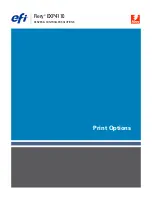
Command Codes
This appendix contains a summary of the command codes sets handled by the resident
emulation's
Introduction
When the printer is set for a particular emulation, it will interpret ONLY the set
of commands belonging to that emulation.
A printer command consists typically of one or more characters imbedded in the
flow of data transmitted to the printer. To make the printer understand which
characters are to be interpreted as commands and which as printable characters,
there is a simple built-in convention: all "characters" that have, according to
the character table, a decimal value less than 32 are interpreted as control
codes. Some of them result in an action, when they are received, others do not.
The ones causing printer action can be found in the command code description.
There is also a special command ESCAPE (decimal code 27, named ESC) which
is used by most printer emulation's to open a command sequence. It is followed by
one or more additional characters, which are identifiers and parameters, belonging
to the printable characters or to those from the range of control codes.
If your printer receives commands which are not compatible with the emulation in
use, it will ignore them, print them as normal characters or even block. Whatever
happens, no serious harm will be done to your printer. To clear the situation,
just reset the printer (hold On Line and press Form Feed for approximately 3
seconds).
PCL III + Multiple ESCape Sequences
If the consecutive ESCape sequences you send to the printer have the same two
characters after the character ESC, you can save time by sending a single multiple
ESC sequence to the printer. This multiple sequence will consist of the ESC
character, the two common character which follow ESC and the remaining characters
of each individual command.
E.g.: if you have to send the sequences: ESC ( s 3 B, ESC ( s 3 T and ESC(s1Q, you
can do so using the multiple sequence ESC ( s 3 b 3 t 1 Q. Note that the last
character of the first two sequences "B" and "T" have become lower case ("b" and
"t" respectively), while the last character of the last sequence
("Q") has remained upper-case (indicating, thus, the end of the multiple
sequence).
PCL III + Attribute Selection Priority
Font
The font selection MUST ALWAYS be indicated in the following order:
1.
Print orientation (PORTRAIT or LANDSCAPE)
2.
Character set (CP 437, etc.)
3.
Character position on the print line (normal, superscript, subscript)
4.
Spacing (fixed or proportional)
5.
Print pitch
6.
Character height (dots)
7.
Style (upright or italic)
8.
Stroke weight (medium or bold)
9.
Typeface (Courier, etc.)
10.
Print quality (DRAFT, NLQ, LQ).
Page layout
The page layout selection MUST ALWAYS be indicated in the following order:
1.
Line feed value
Содержание SuperScript 100C
Страница 9: ...Identifying the Printer Parts ...
Страница 15: ... ...
Страница 31: ...Print Area W M L R Z ...
Страница 44: ......
















































